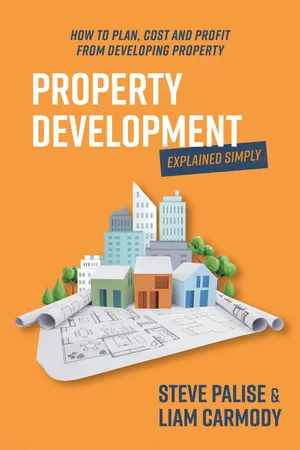
Property Development Explained Simply
How to plan, cost and profit from developing property
- English
- ePUB (mobile friendly)
- Available on iOS & Android
Property Development Explained Simply
How to plan, cost and profit from developing property
About this book
Property development is about 'improving' the land's usable capabilities. This could be anything from turning one house into two duplexes or developing a vacant block into a 500-unit apartment tower. It doesn't always have to be residential to residential: another development scenario is changing the property's use case to improve the land's capabilities (think abandoned warehouse in inner-city Melbourne rezoned and made into boutique townhouses). For many, property is their biggest investment. Property experts Steve Palise and Liam Carmody show you how you can leverage your property to bring greater returns. Property Development Explained Simply comprehensively explains the pros and cons of developing with information that is objective, easy-to-read, factual and concise. Having read the book, you might decide to develop yourself, employ a team to do it for you, or sell your property with permits and plans secured to maximise the sale price of your property. Drawn from Steve Palise and Liam Carmody's own experience as successful property investors and developers, whether you are a wannabe, a rookie or an experienced property developer this comprehensive guide will be invaluable.
Frequently asked questions
- Essential is ideal for learners and professionals who enjoy exploring a wide range of subjects. Access the Essential Library with 800,000+ trusted titles and best-sellers across business, personal growth, and the humanities. Includes unlimited reading time and Standard Read Aloud voice.
- Complete: Perfect for advanced learners and researchers needing full, unrestricted access. Unlock 1.4M+ books across hundreds of subjects, including academic and specialized titles. The Complete Plan also includes advanced features like Premium Read Aloud and Research Assistant.
Please note we cannot support devices running on iOS 13 and Android 7 or earlier. Learn more about using the app.
Information
Table of contents
- Cover
- Title
- Copyright
- Contents
- Why property development?
- Part I: What is property development?
- Part II: Types of property development
- Part III: Beginning a property development
- Part IV: Conveyancing, finance and buying structures
- Part V: Executing the development
- Part VI: Post-development, now what?
- Part VII: Case studies
- Epilogue
- About the authors
- Acknowledgements
- Index